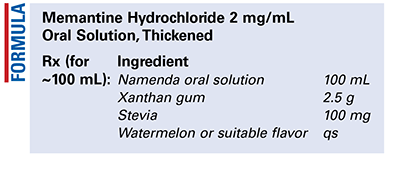US Pharm. 2017;42(11):47-48.

Method of Preparation: Calculate the quantity of each ingredient for the amount to be prepared. Accurately weigh or measure each ingredient. Add the flavor and stevia to the Namenda oral solution and mix well. Add the xanthan gum slowly, with mixing, until it is free of clumps. (A hand-held mixer or homogenizer works well.) Package and label.
Use: Namenda (memantine hydrochloride) is indicated for the treatment of moderate-to-severe dementia of the Alzheimer’s type.
Packaging: Package in tight, light-resistant containers.
Labeling: Keep out of reach of children. Keep refrigerated. Shake well. Discard after ____ [time period].
Stability: Check the current edition of the United States Pharmacopeia for the appropriate beyond-use date for this compounded preparation.1
Quality Control: Quality-control assessment can include theoretical weight compared with actual weight, pH, specific gravity, active drug assay, color, appearance, rheologic properties, and physical observations.2
Discussion: Dysphagia (difficulty swallowing) occurs quite frequently in elderly patients and can significantly impact nutrition, pharmacotherapy, and quality of life. This is especially true of patients with neurologic disorders, including Alzheimer’s disease. An estimated 6 million adults have dysphagia. The lifetime prevalence of swallowing disorders is reported to be as high as 38% in independent-living elderly, and as many as one-half of all residents of long-term-care facilities are affected. The prevalence may be significantly higher in facilities specializing in caring for elderly people with degenerative neurologic disorders. Also, elderly persons tend to spend more time in a recumbent position and often have delayed swallowing and decreased saliva production.3
For patients with dysphagia, there may be specific recommendations regarding diet type, fluid thickness, and other techniques to improve swallowing. The fluid-thickness aspect is an important consideration for pharmacists, who can change the dosage form, including altered-thickness oral liquids (from thick liquids to thin gels and thin pastes). Fluid thickness is often described as thin (water), nectarlike (eggnog), honeylike (honey), or spoon-thick (pudding).3
Numerous viscosity-thickening agents can be incorporated into currently available oral liquid dosage forms, including tragacanth, acacia, silica gel, sodium carboxymethyl cellulose, methylcellulose, carbomers, and xanthan gum.4
Symptoms of Alzheimer’s disease may be reduced by some medications, including memantine (Namenda), an N-methyl-d-aspartate receptor antagonist. Memantine hydrochloride (Namenda, C12H21N·HCl, MW 215.76) occurs as a fine, white to off-white powder that is soluble in water. Namenda is available as tablets or as an oral solution. Namenda oral solution contains memantine hydrochloride in a strength equivalent to 2 mg of memantine hydrochloride in each mL. The oral solution also contains sorbitol solution (70%), methylparaben, propylparaben, propylene glycol, glycerin, natural peppermint flavor #104, citric acid, sodium citrate, and purified water.4
Xanthan gum (corn sugar gum) is a high-molecular-weight polysaccharide gum with a molecular weight of approximately 2 ´ 106. Xanthan gum occurs as a cream-colored or white-colored, odorless, free-flowing, fine powder. It is soluble in cold or warm water, but is practically insoluble in ethanol. Xanthan gum is used as a stabilizing agent and as a viscosity-increasing agent in suspensions. It is nontoxic and is compatible with most other excipients, and it has good stability (in the presence of enzymes, salts, acids, and bases) and viscosity properties over a wide range (pH 3-12). Xanthan-gum solutions can tolerate up to about 60% water-miscible organic solvents, such as ethanol. Xanthan gum is compatible with most synthetic and natural viscosity-increasing agents. The pH of a 1% w/v aqueous solution ranges from 6 to 8. Xanthan gum has also been used to produce controlled-release products.5
Stevia (honey leaf, yerba dulce) powder, a relatively new sweetening agent, is extracted from the leaves of the Stevia rebaudiana Bertoni plant. It occurs as a white, crystalline, hygroscopic powder. Stevia is natural, nontoxic, and safe, and it may be used in both hot and cold preparations. It is also used to decrease the strong bitterness of some drugs.6
REFERENCES
1. U.S. Pharmacopeia/National Formulary [current revision]. Rockville, MD: U.S. Pharmacopeial Convention, Inc; October 2017.
2. Allen LV Jr. Standard operating procedure for performing physical quality assessment of ointments/creams/gels. IJPC. 1998;2:308-309.
3. Bramwell BL. Compliance to treatment in elderly dysphagic patients: potential benefits of alternate dosage forms. IJPC. 2009;13:498-505.
4. Namenda (memantine) package insert. Irvine, CA: Allergan USA, Inc; August 2016.
5. Shah HC, Singh KK. Xanthan gum. In: Rowe RC, Sheskey PJ, Cook WG, Fenton ME, eds. Handbook of Pharmaceutical Excipients. 7th ed. London, England: Pharmaceutical Press; 2012:897-900.
6. Reynolds JEF, ed. Martindale: The Extra Pharmacopoeia. 30th ed. London, England: Pharmaceutical Press; 1993:1049.
To comment on this article, contact rdavidson@uspharmacist.com.





